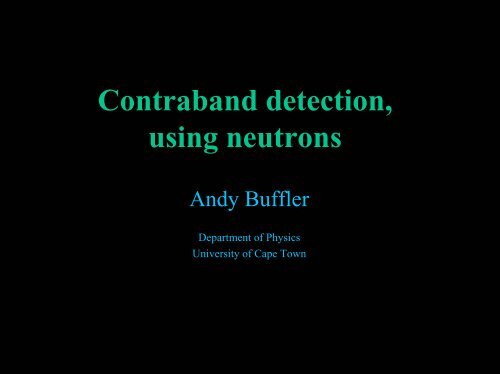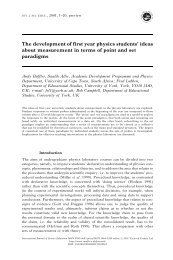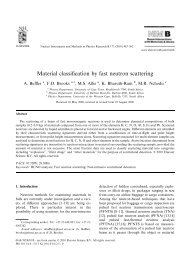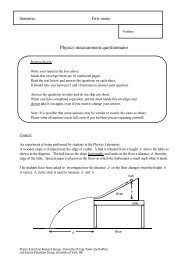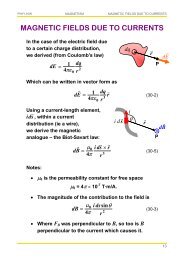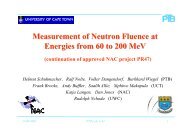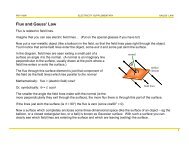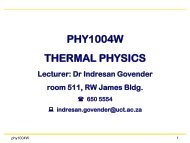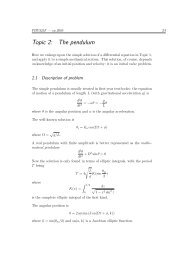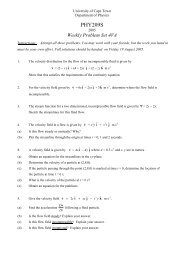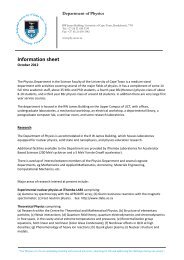Fast Neutron Scattering Analysis - University of Cape Town
Fast Neutron Scattering Analysis - University of Cape Town
Fast Neutron Scattering Analysis - University of Cape Town
Create successful ePaper yourself
Turn your PDF publications into a flip-book with our unique Google optimized e-Paper software.
Contraband detection,<br />
using neutrons<br />
Andy Buffler<br />
Department <strong>of</strong> Physics<br />
<strong>University</strong> <strong>of</strong> <strong>Cape</strong> <strong>Town</strong>
The non-intrusive characterization <strong>of</strong> bulk materials is required in<br />
many industrial and commercial contexts including:<br />
• mining<br />
• food quality control<br />
• containerized waste management<br />
Very <strong>of</strong>ten an analysis <strong>of</strong> the elemental composition <strong>of</strong> the material<br />
is needed, sometimes to form an image <strong>of</strong> the distribution <strong>of</strong> one or<br />
more elements comprising the material.<br />
In particular, there is a growing need for improved techniques to<br />
detect explosives and narcotics hidden in airline luggage and other<br />
containers, and landmines buried in the waters or soil <strong>of</strong> the earth.
Bombing <strong>of</strong> Pan Am Flight 103 (Boeing 747-121)<br />
at Lockerbie, Scotland on 21 December 1988
Terror attacks on<br />
World Trade Centre<br />
and Pentagon<br />
on 11 September 2001
Common approaches to detect hidden contraband include:<br />
X-rays: Well established and highly penetrating but are not sensitive<br />
to the light elements H , C, N and O, and object identification based<br />
mainly on visual imaging.<br />
Dogs: Extremely high success rate (esp. in South Africa) but their use<br />
is disadvantaged by large workloads.<br />
There is a need for alternative technologies which <strong>of</strong>fer high:<br />
• penetrability (to interrogate large containers)<br />
• sensitivity (for low false alarm rates)<br />
• specificity (to detect hidden contraband within a bulk<br />
sample <strong>of</strong> primarily innocuous content)<br />
Nuclear-based approaches <strong>of</strong>fer all <strong>of</strong> these features.
Ammonium Nitrate<br />
Composition B<br />
Composition 4 (C-4)<br />
Dynamite<br />
EGDN<br />
Nitrocellulose<br />
Nitroglycerene<br />
Octogen (HMX)<br />
PETN<br />
Picric Acid<br />
RDX<br />
TNT<br />
Tetryl<br />
Cocaine<br />
Heroin<br />
LSD<br />
Mandrax<br />
Morphine<br />
PCP<br />
Acetamide<br />
Ammonium acetate<br />
Barley<br />
Cotton<br />
Dacron<br />
Ethanol<br />
Lucite (Perspex)<br />
Melamine<br />
Methanol<br />
Neoprene<br />
Nylon<br />
Orlon<br />
Paper<br />
Polyester<br />
Polyethylene<br />
Polyurethane<br />
PVC<br />
Rayon<br />
Silk<br />
Soybean<br />
Sugar<br />
Water<br />
Wood<br />
Wool<br />
H C N O<br />
0 20 40 60 80 100<br />
Atom fraction (%)<br />
Explosives<br />
Illicit drugs<br />
Miscellaneous<br />
substances
Oxygen concentration (moles cm -3 )<br />
0.08<br />
0.07<br />
0.06<br />
0.05<br />
0.04<br />
0.03<br />
0.02<br />
Sand<br />
Water<br />
Sugar<br />
Cellulose<br />
Acryllic<br />
Ethanol<br />
PETN<br />
Nitroglycerine<br />
Nitrocellulose<br />
Picric acid<br />
EGDN<br />
Datasheet<br />
Dynamite<br />
TNT<br />
Black powder<br />
Polyurethane<br />
Tetryl<br />
Ammonium nitrate<br />
Composition B<br />
Cocaine<br />
Bulk nylon<br />
0.01<br />
Cotton<br />
Polyester<br />
Silk<br />
Melamine<br />
0.00 Wool<br />
0.00 0.01 0.02 0.03 0.04 0.05 0.06<br />
Nitrogen concentration (moles cm -3 )<br />
C-3<br />
C-4<br />
HMX<br />
Explosives<br />
Fabrics<br />
Polymers<br />
Miscellaneous materials
Nuclear Physics approaches for elemental analysis<br />
Charged particles p, d, α, … :<br />
Good for surface analyses only<br />
(e.g. Rutherford Backscattering)<br />
Not suitable for bulk objects<br />
α<br />
α<br />
sample<br />
γ-rays:<br />
Penetrating<br />
Not easily applicable to<br />
multi-elemental analyses<br />
<strong>Neutron</strong>s:<br />
Penetrating<br />
Sensitive to both light and heavy elements<br />
Undergo specific interactions with different nuclides<br />
Easily produced and detected<br />
γ<br />
sample<br />
γ’<br />
γ<br />
Transmitted<br />
γ-rays<br />
Compton<br />
scattered γ-rays
<strong>Neutron</strong> – based interrogation methods<br />
sample<br />
thermal<br />
neutrons<br />
γ<br />
Capture γ-rays<br />
fast<br />
neutrons<br />
γ<br />
Inelastic scattering<br />
γ-rays<br />
fast<br />
neutrons<br />
n<br />
Transmitted<br />
neutrons
slow neutrons in,<br />
capture gamma rays out<br />
(thermal neutron capture)<br />
252<br />
Cf source<br />
HPGe<br />
detector<br />
neutron<br />
Gamma<br />
ray<br />
CW agent
Thermal neutron capture<br />
thermal<br />
neutrons<br />
γ<br />
Capture γ-rays
fast neutrons in,<br />
gamma rays out<br />
(fast neutron inelastic scattering)<br />
mono-energetic<br />
fast neutrons<br />
sample<br />
γ<br />
Inelastic<br />
scattering γ-rays<br />
Accelerator-based system using<br />
mono-energetic 8 MeV neutrons<br />
and arrays <strong>of</strong> NaI detectors to<br />
detect de-excitation γ-rays from<br />
neutron inelastic scattering<br />
interactions.
<strong>Fast</strong> neutron<br />
inelastic scattering<br />
mono-energetic<br />
fast neutrons<br />
sample<br />
γ<br />
Inelastic<br />
scattering γ-rays<br />
Portable system based<br />
around a 14 MeV sealed<br />
tube neutron generator and<br />
BGO detector to detect deexcitation<br />
γ-rays from<br />
neutron inelastic<br />
scattering interactions.<br />
Pulsed Elemental <strong>Analysis</strong> with <strong>Neutron</strong>s (PELAN)
fast neutrons in, fast neutrons out<br />
(fast neutron transmission spectroscopy)<br />
fast “white”<br />
neutron beam<br />
n<br />
transmitted<br />
neutrons<br />
10<br />
ENDF/B-VI<br />
1<br />
H<br />
<strong>Scattering</strong> cross section (b)<br />
8<br />
6<br />
4<br />
12 C<br />
14<br />
N<br />
16<br />
O<br />
<strong>Neutron</strong> beam transmitted<br />
through the sample is<br />
attenuated according to<br />
total scattering cross<br />
section for each element.<br />
2<br />
0<br />
0 5 10 15<br />
Incident neutron energy (MeV)
<strong>Neutron</strong>s in, neutrons out<br />
fast<br />
neutrons<br />
n, n’<br />
Elastically and<br />
inelastically<br />
scattered neutrons<br />
The energy and intensity distributions <strong>of</strong> the scattered neutron<br />
field are functions <strong>of</strong> the:<br />
• incident neutron energy<br />
• angle <strong>of</strong> scattering<br />
• mass <strong>of</strong> the scattering nuclide
<strong>Fast</strong> <strong>Neutron</strong> <strong>Scattering</strong> <strong>Analysis</strong> (FNSA)<br />
Andy Buffler , Frank Brooks, Saalih Allie<br />
Department <strong>of</strong> Physics, <strong>University</strong> <strong>of</strong> <strong>Cape</strong> <strong>Town</strong>, South Africa<br />
Krish Bharuth-Ram<br />
Department <strong>of</strong> Physics, <strong>University</strong> <strong>of</strong> Durban-Westville, South Africa<br />
Rudolph Nchodu<br />
Department <strong>of</strong> Physics, <strong>University</strong> <strong>of</strong> the Western <strong>Cape</strong>, South Africa<br />
See:<br />
Buffler and Brooks et al, “Material classification by fast neutron scattering”,<br />
Nuclear Instruments and Methods B 173 (2001) 483
National Accelerator Centre, near <strong>Cape</strong> <strong>Town</strong>, South Africa
<strong>Fast</strong> <strong>Neutron</strong> <strong>Scattering</strong> <strong>Analysis</strong> (FNSA)<br />
Concept:<br />
Basic approach is to irradiate the sample under interrogation<br />
with a beam <strong>of</strong> fast mono-energetic neutrons and to detect the neutrons<br />
scattered out <strong>of</strong> the beam.<br />
Nuclide-specific information is present in the scattered neutron field.<br />
By detecting the neutrons elastically and inelastically scattered at<br />
different laboratory angles θ for different incident neutron energies E o<br />
, the<br />
amounts and positions <strong>of</strong> the scattering nuclides may be determined.<br />
monoenergetic<br />
neutron beam<br />
shielding<br />
Backward<br />
detector (B)<br />
scattering<br />
sample<br />
150°<br />
45°<br />
Forward<br />
detector (F)
1500 mm<br />
300 mm<br />
600 mm<br />
400 mm<br />
310 mm<br />
d<br />
Dtarget:<br />
2<br />
H(d,n) He<br />
reaction<br />
2 3<br />
Iron<br />
Borated<br />
wax<br />
n<br />
Sample<br />
Rotating<br />
Havar foil<br />
(E = 4.7/4.0 MeV)<br />
d<br />
M<br />
NE213<br />
Detector B<br />
θ<br />
B = 150o<br />
θ F<br />
= 45 o<br />
NE213<br />
Detector F<br />
Laboratory scattering experiments undertaken at the 6 MV<br />
Van de Graaff accelerator <strong>of</strong> the National Accelerator Centre, South Africa.<br />
• <strong>Neutron</strong> energy multiplexed between 7.5 MeV and 6.8 MeV by rotating<br />
a 11µm Havar foil in and out <strong>of</strong> the 4.5 MeV deuteron beam.<br />
• Pulse shape discrimination on all NE213 detectors.<br />
• Pulse height and time-<strong>of</strong>-flight information measured for small monoelemental<br />
samples, as well <strong>of</strong> compounds <strong>of</strong> known and “unknown”<br />
chemical composition.
<strong>Neutron</strong> elastic scattering<br />
(a) 12 C(n,n) 12 C<br />
Differential<br />
cross section<br />
dσ/dΩ (b sr -1 )<br />
4.0<br />
3.0<br />
2.0<br />
1.0<br />
0.0<br />
1.0 0.5 0.0 -0.5 1.0<br />
-1.0<br />
2.0<br />
3.0<br />
6.0<br />
5.0<br />
4.0<br />
E o<br />
(MeV)<br />
7.0<br />
8.0<br />
cos Θ<br />
)<br />
E scattered<br />
/ E incident<br />
for neutron<br />
1.0<br />
0.8<br />
0.6<br />
0.4<br />
0.2<br />
Kinematics<br />
A=1<br />
0.0<br />
0 30 60 90 120 150 180<br />
<strong>Neutron</strong> laboratory scattering angle (degrees)<br />
A=207<br />
A=56<br />
A=27<br />
A=16<br />
A=14<br />
A=12<br />
A=10<br />
A=7<br />
A=4<br />
A=2<br />
(b) 14 N(n,n) 14 N<br />
dσ/dΩ (b sr -1 )<br />
4.0<br />
3.0<br />
2.0<br />
1.0<br />
0.0<br />
1.0 0.5 0.0 -0.5 1.0<br />
-1.0<br />
(c) 16 O(n,n) 16 O<br />
dσ/dΩ (b sr -1 )<br />
4.0<br />
3.0<br />
2.0<br />
1.0<br />
cos Θ<br />
0.0<br />
1.0 0.5 0.0 -0.5 1.0<br />
-1.0<br />
2.0<br />
2.0<br />
3.0<br />
3.0<br />
5.0<br />
4.0<br />
E o<br />
(MeV)<br />
6.0<br />
6.0<br />
5.0<br />
4.0<br />
E o<br />
(MeV)<br />
7.0<br />
7.0<br />
8.0<br />
8.0<br />
cos Θ
Pulse height (L) channel<br />
60 40 20 0<br />
14E3<br />
γ<br />
7E3<br />
0<br />
0 10 20 30 40 50 60<br />
Pulse shape (S) channel<br />
Counts<br />
80E3<br />
40E3 γ n<br />
0<br />
γ n<br />
50E3<br />
25E3<br />
Pulse height (L) channel<br />
0 20 40 60<br />
n<br />
0
Pulse height and/or time-<strong>of</strong> flight measurements are made<br />
at 2 scattering angles and 2 neutron beam energies.<br />
Time-<strong>of</strong>-flight<br />
Pulse height<br />
Graphite scatterer<br />
E n = 7.5 MeV<br />
Detector at 150°
θ lab<br />
: 150 o<br />
45 o<br />
Parameter: Pulse height Time-<strong>of</strong>-flight<br />
R i<br />
(n)<br />
800<br />
400<br />
0<br />
400<br />
H<br />
C<br />
S D0<br />
signature<br />
(based on both pulse<br />
height and time-<strong>of</strong> flight)<br />
θ lab<br />
: 150 o<br />
800<br />
400<br />
0<br />
400<br />
H<br />
C<br />
45 o<br />
0<br />
400<br />
N<br />
R i<br />
(n)<br />
0<br />
400<br />
N<br />
0<br />
400<br />
O<br />
E o = 6.8 MeV<br />
0<br />
400<br />
O<br />
0<br />
400<br />
Al<br />
E o = 7.5 MeV<br />
0<br />
400<br />
Al<br />
0<br />
400<br />
S<br />
0<br />
400<br />
S<br />
0<br />
400<br />
Fe<br />
S L0<br />
signature<br />
0<br />
400<br />
Fe<br />
0<br />
400<br />
Pb<br />
0<br />
0 150 300 450 600 750 900<br />
Bin number n<br />
(based on pulse height<br />
only – does not require<br />
a pulsed beam)<br />
0<br />
400<br />
Pb<br />
0<br />
0 150 300 450 600<br />
Bin number n
<strong>Scattering</strong> signatures measured<br />
for unknown samples are<br />
unfolded to determine the<br />
elemental composition <strong>of</strong> the<br />
sample:<br />
N+<br />
Sn ( ) f R( n)<br />
= ∑ 4<br />
i = 1<br />
i<br />
i<br />
S(n)<br />
200<br />
150<br />
100<br />
50<br />
Hist Data<br />
Fit<br />
Background<br />
0<br />
0 150 300 450 600 750 900<br />
where:<br />
S(n) : scattering signature measured for a sample <strong>of</strong> unknown composition<br />
R i<br />
(n) : scattering signatures measured for N individual elements<br />
and 4 background components<br />
(±∆f i<br />
) : fitting coefficients<br />
f i<br />
n<br />
The atom fraction a i<br />
a<br />
i<br />
for each element in the unknown compound is simply<br />
f<br />
i<br />
= N<br />
∑<br />
i = 1<br />
f<br />
i<br />
The atom fractions a i<br />
±∆a i<br />
uniquely characterize the elemental composition<br />
<strong>of</strong> the scattering sample.
<strong>Scattering</strong> signatures<br />
measured for unknown<br />
samples are unfolded to<br />
determine the elemental<br />
composition <strong>of</strong> the sample.<br />
The measured atom<br />
fractions uniquely<br />
characterize the<br />
elemental composition <strong>of</strong><br />
the scattering sample.<br />
atom fraction<br />
0.8<br />
0.6<br />
0.4<br />
0.2<br />
0.0<br />
Methanol Ammonium Heroin<br />
nitrate simulant<br />
HCNOAlSFePb<br />
HCNOAlSFePb<br />
HCNOAlSFePb<br />
The identification <strong>of</strong> specific materials from measured atom<br />
fractions can be facilitated by introducing a χ 2 -based screening<br />
procedure to compare the atom fractions measured for an<br />
“unknown” sample with the known atom fractions <strong>of</strong> a large set <strong>of</strong><br />
candidate materials.
Results from analyses<br />
using scattering<br />
signatures based on:<br />
atom<br />
fraction<br />
0.8<br />
0.6<br />
Methanol Ammonium Acetamide Ammonium<br />
nitrate acetate<br />
(a) both pulse height<br />
and time-<strong>of</strong>-flight<br />
0.4<br />
0.2<br />
a i<br />
0.8<br />
0.6<br />
0.0<br />
0.0<br />
atom<br />
fraction<br />
Methanol Ammonium Acetamide Ammonium<br />
nitrate acetate<br />
(b) pulse height only<br />
a i<br />
0.4<br />
0.2<br />
Histogram: Expected<br />
H C N O Al S Fe Pb
The sensitivity <strong>of</strong> the approach for detecting particular materials<br />
is illustrated by introducing a function analogous to a weighted<br />
chi-square coefficient:<br />
2<br />
N<br />
⎛ ai<br />
− bik<br />
⎞<br />
∑⎜<br />
⎟<br />
2<br />
i = 1⎝<br />
∆ai<br />
χ =<br />
⎠<br />
x<br />
( k)<br />
N<br />
−2<br />
N ∑ai<br />
i = 1<br />
where:<br />
a i<br />
±∆a i<br />
: are the measured atom fractions for N<br />
candidate elements in sample x<br />
b ik<br />
: the corresponding atom fractions for a candidate<br />
material k <strong>of</strong> known chemical composition.<br />
More convenient to use a screening function P x<br />
(x,k) defined by<br />
normalizing each calculated χ 2 (k) value to a percentage value by<br />
P<br />
x<br />
( x, k)<br />
=<br />
100<br />
2<br />
x<br />
( k)<br />
45<br />
−1<br />
(<br />
2<br />
∑ χ ( ))<br />
x<br />
k<br />
k = 1<br />
χ
Screening materials k = 1 to 45<br />
The atom fractions measured for<br />
each “unknown” sample x are<br />
screened against candidate<br />
materials, e.g. the following set<br />
<strong>of</strong> 8 elements, 10 explosives,<br />
5 illicit drugs and 22 common<br />
substances.<br />
Elements:<br />
Common substances:<br />
1 Hydrogen 24 Paraffin wax<br />
2 Carbon 25 Polyethylene<br />
3 Nitrogen 26 Ethanol<br />
4 Oxygen 27 Methanol<br />
5 Aluminium 28 Water<br />
6 Sulphur 29 Ammonium acetate<br />
7 Iron 30 Nylon<br />
8 Lead 31 Lucite<br />
32 Polyurethane<br />
Explosives: 33 Acetamide<br />
9 Ammonium nitrate 34 Benzene<br />
10 C-4 35 Sugar<br />
11 RDX/HMX 36 Iron sulphate<br />
12 EGDN 37 Wood<br />
13 PETN 38 Paper<br />
14 Nitrocellulose 39 Cotton<br />
15 Nitroglycerine 40 Silk<br />
16 TNT 41 Orlon<br />
17 Tetryl 42 Wool<br />
18 Picric acid 43 Melamine<br />
44 Polyester<br />
Illicit drugs: 45 Aluminium oxide<br />
19 Heroin<br />
20 LSD<br />
21 Cocaine<br />
22 Morphine<br />
23 Mandrax
P x<br />
(x,k) represents the degree to which a sample x matches a<br />
member k <strong>of</strong> the set <strong>of</strong> 45 candidate materials.<br />
The distribution <strong>of</strong> P x<br />
(x,k) versus k displays a pr<strong>of</strong>ile <strong>of</strong> the<br />
screening <strong>of</strong> x against the 45 candidate materials, with peaks at the<br />
values <strong>of</strong> k corresponding to the most probable candidate<br />
materials.<br />
Acetamide<br />
P(x,k)<br />
100<br />
80<br />
Element Explosive Drug Common substance<br />
Acetamide<br />
60<br />
40<br />
20<br />
0<br />
0 5 10 15 20 25 30 35 40 45<br />
Material k
P(x,k)<br />
100<br />
80<br />
Ammonium nitrate<br />
(Explosive)<br />
Heroin simulant<br />
(Illicit drug)<br />
100<br />
80<br />
P(x,k)<br />
60<br />
60<br />
40<br />
40<br />
20<br />
20<br />
P(x,k)<br />
100<br />
0<br />
0 15 30 45<br />
80<br />
Methanol<br />
(Common material)<br />
Material k<br />
0<br />
0 15 30 45<br />
Ammonium acetate<br />
(Common material)<br />
100<br />
80<br />
P(x,k)<br />
60<br />
40<br />
20<br />
60<br />
40<br />
20<br />
0<br />
0 15 30 45<br />
Material k<br />
0<br />
0 15 30 45
Ammonium Nitrate<br />
Composition B<br />
Composition 4 (C-4)<br />
Dynamite<br />
EGDN<br />
Nitrocellulose<br />
Nitroglycerene<br />
Octogen (HMX)<br />
PETN<br />
Picric Acid<br />
RDX<br />
TNT<br />
Tetryl<br />
Cocaine<br />
Heroin<br />
LSD<br />
Mandrax<br />
Morphine<br />
PCP<br />
Acetamide<br />
Ammonium acetate<br />
Barley<br />
Cotton<br />
Dacron<br />
Ethanol<br />
Lucite (Perspex)<br />
Melamine<br />
Methanol<br />
Neoprene<br />
Nylon<br />
Orlon<br />
Paper<br />
Polyester<br />
Polyethylene<br />
Polyurethane<br />
PVC<br />
Rayon<br />
Silk<br />
Soybean<br />
Sugar<br />
Water<br />
Wood<br />
Wool<br />
H C N O<br />
0 20 40 60 80 100<br />
Atom fraction (%)<br />
Explosives<br />
Illicit drugs<br />
Miscellaneous<br />
substances
In many practical situations it may not be<br />
important to determine the actual type <strong>of</strong><br />
material, but rather the group (explosive,<br />
illicit drug, common substance) to which<br />
the material belongs.<br />
This identification is assisted by<br />
introducing a group pr<strong>of</strong>ile function<br />
G(x,g) for unknown sample x, by<br />
summing P(x,k) over the members k <strong>of</strong><br />
each group g :<br />
Gxg ( , ) = ∑ Pxk ( , )<br />
over each<br />
group<br />
where the 4 groups are:<br />
1. Elements<br />
2. Explosives<br />
3. Illicit drugs<br />
4. Common materials<br />
(a) Methanol<br />
100<br />
G(x,g)<br />
50<br />
0<br />
(b) Acetamide<br />
100<br />
G(x,g)<br />
50<br />
0<br />
(c) Ammonium nitrate<br />
100<br />
G(x,g)<br />
50<br />
0<br />
(d) Drug simulant<br />
100<br />
G(x,g)<br />
50<br />
0<br />
g = Element Drug<br />
Explosive Common material
A group probability function<br />
indicates the relative probability<br />
that the atom fractions measured<br />
by FNSA for a test sample match<br />
those for compounds in each <strong>of</strong><br />
the four groups:<br />
Pure elements<br />
Explosives<br />
Illicit drugs<br />
Common substances<br />
Probability that sample belongs to material group<br />
100<br />
Methanol<br />
50<br />
0<br />
100<br />
50<br />
Ammonium nitrate<br />
0<br />
100<br />
Heroin simulant<br />
50<br />
Methanol<br />
Heroin simulant<br />
Ammonium<br />
nitrate<br />
Results in a highly reliable<br />
classification which is suitable to<br />
the detection <strong>of</strong> explosives and<br />
illicit drugs.<br />
0<br />
Pure<br />
Element<br />
Explosive<br />
Illicit<br />
drug<br />
Common<br />
substance
Panel on the assessment<br />
<strong>of</strong> the practicality <strong>of</strong><br />
Pulse <strong>Fast</strong> <strong>Neutron</strong><br />
Transmission Spectroscopy<br />
for Aviation Safety<br />
Report: 1999<br />
Washington D.C.<br />
Recommendations:<br />
1. Do not consider accelerator-based technologies to have promise for<br />
deployment as a primary screening procedure for checked baggage<br />
inspection. Any screening procedure relying on an accelerator cannot compete<br />
with available technologies on either cost or practicality bases<br />
2. Do not fund any large accelerator-based hardware development<br />
projects. Combinations <strong>of</strong> experimental work with existing laboratory<br />
equipment, mathematical modeling and simulation can better define the<br />
potential <strong>of</strong> nuclear technologies without the expense or time required to design<br />
and build new hardware.
Location <strong>of</strong> contraband in FNSA measurements<br />
Rotate and translate package across collimated beam.<br />
Backward<br />
detector<br />
Forward<br />
detector<br />
Package<br />
Collimated<br />
mono-energetic<br />
neutron beam<br />
Transmission<br />
detector<br />
Shielding<br />
Rotating<br />
turntable<br />
Translating<br />
trolley
Results from a Rotational-Translational scan<br />
Counts measured at 45°<br />
as a function <strong>of</strong><br />
x (translational coordinate) and<br />
θ (rotational coordinate)<br />
explosive<br />
illicit drug<br />
dense cotton clothing<br />
packed in suitcase
Results from a<br />
Rotational-Translational<br />
scan<br />
(a) transmission detector<br />
(b) 45° detector<br />
(c) 150° detector (H-suppressed)<br />
(d) 150° detector (H-enhanced)<br />
water<br />
graphite<br />
air
Results from a<br />
Rotational-Translational<br />
scan<br />
(a) transmission detector<br />
(b) 45° detector<br />
(c) 150° detector (H-suppressed)<br />
(d) 150° detector (H-enhanced)<br />
explosive<br />
illicit drug<br />
dense cotton clothing
Detection <strong>of</strong> explosives in airline baggage by FNSA<br />
Focus on screening <strong>of</strong> outgoing baggage – requirements include<br />
high throughput and low false alarm rate.<br />
Signal: High density region (1.6 – 2.0 g cm -3 )<br />
Appropriate HCNO atom fraction<br />
High concentration <strong>of</strong> HCNO<br />
Effective explosive detection systems must <strong>of</strong>fer:<br />
(a) Rapid operation (< 20 s per bag)<br />
(b) Reliable detection<br />
Zero false negative rate (must detect all explosives > 200 g)<br />
Small false positive rate (few false alarms)<br />
(c) Safe use<br />
(d) Ease <strong>of</strong> use<br />
Not clear whether or not the new generation <strong>of</strong> X-ray systems will<br />
fully meet all these requirements.
Multi-stage interrogation protocol for explosives in outgoing luggage<br />
STAGE 1<br />
First (rapid) screening using<br />
X-ray method (10 seconds)<br />
Bag “suspect” ?<br />
No<br />
Yes<br />
(~3% <strong>of</strong> bags)<br />
FNSA could be used as<br />
the second-stage <strong>of</strong> a<br />
second phase <strong>of</strong> a<br />
two-stage screening<br />
system, in order to<br />
provide corroborative<br />
evidence via an<br />
independent and more<br />
sensitive screening<br />
Bag moved to STAGE 2 station<br />
STAGE 2<br />
Suspicious voxel(s) positioned in neutron beam<br />
Thorough FNSA screening (1 – 2 minutes)<br />
Bag still “suspect” ?<br />
STAGE 3<br />
Visual inspection<br />
No<br />
Yes<br />
( < 0.1% <strong>of</strong> bags)
Detection <strong>of</strong> illicit drugs in airline baggage by FNSA<br />
Focus on the screening <strong>of</strong> incoming baggage<br />
Signal:<br />
Appropriate HC atom fraction<br />
High H concentration<br />
Requirements less stringent and less precise than<br />
for explosives detection.<br />
(Detecting > 0.5 kg <strong>of</strong> illicit drugs with 90% efficiency is useful.)
Proposed system for the<br />
detection <strong>of</strong> illicit drugs in<br />
incoming airline luggage.<br />
FNSA could be used as the<br />
first stage <strong>of</strong> a two-stage<br />
screening system.<br />
The second stage is<br />
manual inspection by<br />
customs <strong>of</strong>ficials.<br />
<strong>Neutron</strong>s scattered out<br />
<strong>of</strong> the beam by a passing<br />
suitcase are detected in<br />
arrays <strong>of</strong> neutron detectors<br />
placed at forward and<br />
backward angles.<br />
backward<br />
neutron<br />
detectors<br />
fan<br />
beam<br />
collimator<br />
fast<br />
neutron<br />
source<br />
forward<br />
neutron<br />
detectors<br />
neutron<br />
beam<br />
luggage<br />
conveyor<br />
backward<br />
neutron<br />
detectors<br />
shielding
FNSA screening times per suspect item:<br />
<strong>Neutron</strong> source type<br />
STNG Accelerator Accelerator STNG<br />
E (MeV) 2.5 4.2 7.2 14.1<br />
φ (E ) (× 10 6 s -1 ) 1 0.145 1.13 10<br />
t M (s) 2.8 18.8 3.5 0.94<br />
E : neutron beam energy<br />
φ (E) : number <strong>of</strong> source neutrons incident on sample per second<br />
t M<br />
: FNSA measuring time per suspect item<br />
In addition, need to include time for:<br />
<strong>Neutron</strong> fluence reduction due to attenuation:<br />
Preliminary RT-scan:<br />
Computing:<br />
Mounting and positioning:<br />
10 - 30 s<br />
10 - 30 s<br />
5 - 10 s<br />
10 - 20 s<br />
⇒<br />
Total time for FNSA screening: 60 to 120 s per suspected item.
Conclusions<br />
Laboratory tests have shown that FNSA is a highly reliable<br />
method for characterizing materials in bulk.<br />
FNSA measures the important elements for contraband detection<br />
(H, C, N and O) with similar sensitivity.<br />
FNSA is complementary to other techniques employing<br />
mono-energetic neutron beams.<br />
Present work on FNSA is being directed towards the<br />
determination <strong>of</strong> the most suitable system parameters for practical<br />
applications, before constructing a prototype to subject to further<br />
testing and evaluation.


